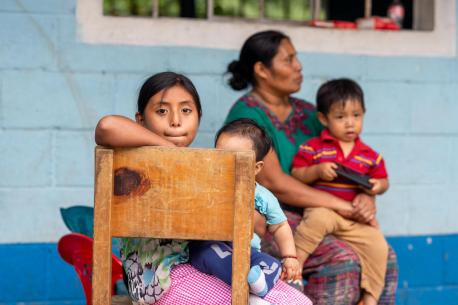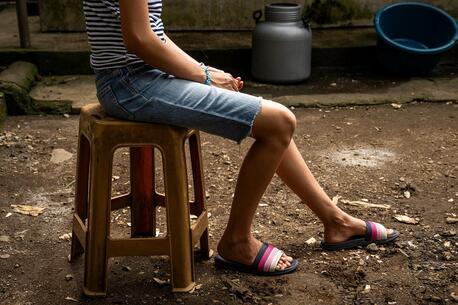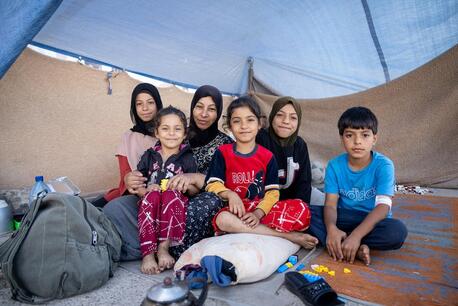
Inside Look: COVID-19 and Child Protection in Guatemala
What it means to be a child migrant during a pandemic, & how UNICEF is tackling the issues that force children to flee in the first place.
Justo Solorzano, Chief Child Protection Officer for UNICEF Guatemala, recently spoke with Eitan Peled, Child Migration & Protection Program Manager for UNICEF USA, about what it means to be a child migrant during the COVID-19 pandemic — and how UNICEF works with partners in country to address the issues that force children and families to flee in the first place. The following are excerpts from their conversation, edited and condensed.
Please tell us a little bit about yourself and about your role at UNICEF Guatemala.
JUSTO SOLORZANO: I am in charge of UNICEF’s child protection team in Guatemala. We work directly with the Guatemalan government and civil society to increase and scale up national services to prevent and respond to child victims of violence across the country. My team and I give technical support to the authorities in charge of these issues. We also work with municipal governments to promote local plans to prevent violence against children, and to detect cases where children have suffered from violence or are at risk of violence.
One of our objectives is to reduce impunity in crimes against children. Working with judges, prosecutors, investigators and law enforcement officials, we are supporting government efforts to create protocols and policies within the framework of the international Convention on the Rights of the Child (which UNICEF supports, and Guatemala has signed and ratified along with 196 other countries and territories; the United States is the only UN countries that has not ratified).

Poverty continues to be one of the main drivers of migration from Guatemala to Mexico and the U.S. Says Justo Solorzano, Chief Child Protection Officer for UNICEF Guatemala: "We don’t want this, but we expect the numbers of migrating children and adolescents to remain high and even to increase." © UNICEF/UN0370125/Mussapp
We invest a lot of time in training and educating national functionaries to increase their capacity to attend to child victims. We worked with the National Congress on new legislation to protect children from violence, including sexual violence and abuse. And we’ve helped establish mechanisms for searching for children who are reported missing.
Amazing. How has the current pandemic affected your work and the situation for children and families in Guatemala?
JUSTO SOLORZANO: The COVID situation is very complex. Due to the COVID emergency, Guatemala closed its borders, but continued to allow entry of Guatemalan nationals — adults and children, accompanied or unaccompanied — who are deported from the U.S. or from Mexico.
For those children who are in residential care, there have been different effects. A large proportion of those who would normally be staffing the residential facilities for returning migrants have health conditions that make it too risky for them to report to work. Meanwhile, the number of children being cared for in these facilities continues to increase. Courts are closed due to the pandemic, so many cases remain in limbo; there are some children waiting to be reintegrated with their families and communities and others who may need additional protections or other services.
Our child protection team is working with local authorities to expand our reach as best we can to prevent violence against children during the pandemic. We support local partners who organize activities to occupy children while their schools are closed, to prevent them from becoming isolated. There are also reports of increased violence against children while in isolation, so these activities can help identify cases where we need to intervene.
Poverty, exclusion, violence and a desire to reunite with family members — these were the prevailing drivers of migration before the pandemic and they are the main drivers now.
Taking a step back: can you talk about the situation in Guatemala, why children and families leave in the first place? What is it that drives them to flee? And what has changed during COVID?
JUSTO SOLORZANO: Poverty, exclusion, violence and a desire to reunite with family members — these were the prevailing drivers of migration before the pandemic, and they are the main drivers now. We don’t want this, but we expect the numbers of migrating children and adolescents to remain high and even to increase.
Parents don't want to live in a place where their sons and daughters are exposed to such a high level of violence. Guatemala is one of the most violent countries in the region. It has the second-highest rate of adolescent homicide in the world.
And the attitude toward violence here, especially domestic violence, is to a large extent one of resignation and acceptance. The official response to violence is mostly informed by a security and crime reduction lens rather than prevention, restoration and rehabilitation. Local authorities do not have the capacity to address the high level of violence people live with day to day.
Local authorities do not have the capacity to address the high level of violence people live with day to day.
Let me tell you a story. It’s about a 16-year-old I’ll call Claudia. Claudia has an infant daughter, the result of her having been gang raped while walking home late from school one night in early 2018. Claudia's father migrated to the U.S. over a decade ago. He was seeking the American Dream. He wanted to give his family a better future. Eventually Claudia’s mother and younger brother followed, but Claudia stayed behind and had been living on her own when the attack occurred. Claudia told me the men who attacked would call her afterward, threatening further harm if she reported the incident to the authorities. They told her they knew her schedule and her whereabouts, and they knew she was alone.
After Claudia discovered she was pregnant, she waited two months to call her mom. That was when she decided to go to the U.S. She left Guatemala in late February, when her daughter was 11 months old. She joined a group that had paid a coyote, or smuggler, to take them to the border. Claudia’s plan was to submit to border authorities when she arrived, but the coyote told her it was only a few hours walk through the desert, so she agreed to go along. The trip was very hard for her, and for her baby, and she fell behind. While she was separated from the group, the coyote approached her and threatened her safety, but then two men from the group who had sensed something was wrong intervened. Claudia was able to continue the journey with another Guatemalan woman who was also traveling with her daughter.
After a while, though, Claudia and her companion grew afraid that they were lost, and called 911. American authorities picked them up and took them to what Claudia thinks was a police station in Arizona (though I imagine it was a border patrol station), where she was placed in a detention cell along with her daughter. By then she had been traveling for three months. She doesn't remember the exact day she arrived in the U.S. She remembers getting a call from someone from the Guatemalan Consulate. Claudia told the officer her story and why she had traveled to the United States. The officer told her that nothing could be done; applications for asylum were no longer being processed by the U.S. government under the guise of public health. And she was sent back to Guatemala.
Claudia is now back living in her community with her daughter. Her mother, her father and her brother are all in the U.S. She is getting support from UNICEF, from other NGOs and from the government. But she's in a very difficult situation.
What a heartbreaking story. It really speaks to the reality of the violence, the sexual violence in Guatemala and the lack of capacity for authorities to respond because of the fact that the gangs are in control.
How is UNICEF Guatemala supporting violence reduction and prevention efforts, to try and make it so that people like Claudia don't have to flee in the first place?
JUSTO SOLORZANO: On one level, UNICEF supports the municipal governments to create local plans to prevent violence against children. This way we can work very closely with the children to try to meet their needs. There are many gaps; for every three adolescents who are attending secondary school, there are another seven who are not. So where are they? What are they doing? This is the challenge. We work with the education ministry to promote alternative education, formal and informal, for those other seven. UNICEF also supports parents, to educate them on how to educate their children.
Supporting the reintegration of returning migrants while protecting their health and well-being
We are also supporting the government to create and implement protocols to manage cases like Claudia’s. Ways to reintegrate children who are returned after migrating north. Promoting their reintegration into the communities, with a framework for protecting their health and well-being.
UNICEF will be creating and disseminating messages to address the stigma faced by returned children, child migrants, to their communities, to address community fears that those who are deported may be bringing COVID-19 back with them.
UNICEF is also working to build national and local capacities to prevent, detect and address gender-based violence against children, girls and women. This includes working with the justice system, to provide technical assistance so they can [adjudicate cases virtually]. A new government took office in January, and so we will be working with them on social policies related to child protection services, education, health and other areas.
Wonderful. What I find so powerful about child protection programming is that it cuts across so many areas. The violence prevention and detection that you mentioned is tied to education, right? Because when kids are in school, and they're learning and dreaming, when they're ambitious, then they're less inclined to have to leave. They're more likely to be able to make a living and keep away from the gangs.
I understand that UNICEF also provides mental health support and services for child migrants who are returned. How is that program working now, during COVID?
JUSTO SOLORZANO: When child migrants from Guatemala are returned — by plane from the U.S. or by bus from Mexico — they are received by child protection authorities, whom we support, and are transported to shelters, which we also support, and where psychosocial teams conduct interviews to assess their needs. Child protection officers also contact the families.
After a COVID test, if the child is negative, he or she is transferred to their community and brought to their families. The child protection authorities maintain a dialogue with the family, and continue to monitor the situation, because it is very important to follow every case and make sure they are getting the psychosocial support they need.
It's incredible, but many [migrant] children who are returned try to leave again a month or so later, so it's important for us to scale up our reintegration services so they do not feel the need to do so.
It’s incredible, but many children who are returned try to leave again a month or so later, so it's important for us to scale up our reintegration services so that they do not feel the need to do so.
If a child’s COVID test is positive, they and anyone else they may have been traveling with has to quarantine in another shelter for 10 or 25 days. They can return to their communities after that. The big challenge with that is we need a lot of human resources to support the process of making sure they are safely reintegrated and receive continued support. We need psychologists, social workers, nurses and doctors. The government does not have enough resources.
Another challenge is the availability of shelters. There are strict sanitary measures to adhere to. You need a room for every child, a room for every adolescent. The government has had to rent hotel rooms to make sure there is space to quarantine every child who needs to quarantine. UNICEF is supporting that as well. We are paying for shelters and food and providing masks and other personal protective equipment to staff. We plan to continue working closely with the government, and with civil society to support child migrants.
How is UNICEF helping indigenous kids and indigenous populations here? How has UNICEF’s programming had to change or adapt based on their unique needs?
JUSTO SOLORZANO: For one thing, we have to translate all our messaging into 20 different languages. Throughout the pandemic we have been disseminating messages on COVID-19 prevention, about violence prevention, translated into the different languages. We have to respect their culture and the government doesn’t have the capacity to do this, so we are doing it. The National Academy of Mayan Languages is one of our partners and we support them in their efforts to train the national authorities, enhancing the understanding of children from these areas.
Indigenous children are among the most affected by poverty and violence in Guatemala
Indigenous children are among the most affected by poverty and by violence. We work very closely with local government authorities, which includes indigenous leaders, to work at the community level to strengthen protections for children. We’ve developed a guide to prevent COVID and to prevent violence against children. We also have partners working at the community level. We hire a lot of people, including social workers who speak the same language as the indigenous populations.
You really won't stop just because the kids are hard to reach.
JUSTO SOLORZANO: It is hard work. Every day we confront different situations that affect children and adolescents. On the other hand, when we talk with children, when we talk with adolescents, when we facilitate their interactions with a psychologist or social worker, at the end of the day, the children are happy and that gives us a lot of esperanza, a lot of hope. We get our energy from them.
What can people do to help you and the team out?
JUSTO SOLORZANO: Promote children's rights in your own community, in your own family. And give to UNICEF, knowing that every dollar that you invest in our work is used in a good way, in a correct way and in a transparent way to benefit children.
Support UNICEF's efforts to save and protect kids no matter where they live or where they are from.
Top photo: Juana, 9, photographed with her mother and siblings at a shelter in Campur, San Pedro Carchá, Alta Verapaz, Guatemala, on Nov. 17, 2020. The COVID-19 pandemic and back-to-back hurricanes have been devastating for the country, where 60 percent of the population was already living in poverty. © UNICEF/UN0377655/Billy/AFP-Services
HOW TO HELP
There are many ways to make a difference
War, famine, poverty, natural disasters — threats to the world's children keep coming. But UNICEF won't stop working to keep children healthy and safe.
UNICEF works in over 190 countries and territories — more places than any other children's organization. UNICEF has the world's largest humanitarian warehouse and, when disaster strikes, can get supplies almost anywhere within 72 hours. Constantly innovating, always advocating for a better world for children, UNICEF works to ensure that every child can grow up healthy, educated, protected and respected.
Would you like to help give all children the opportunity to reach their full potential? There are many ways to get involved.




